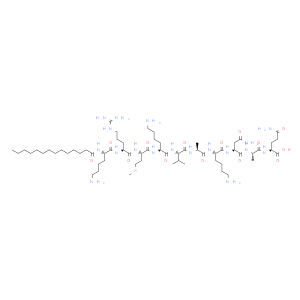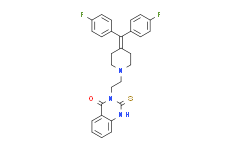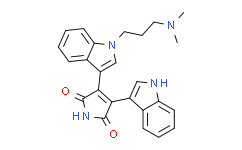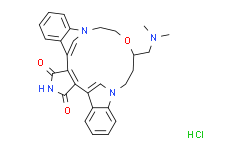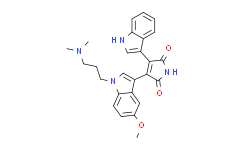| 中文名称: | Pep2m, myristoylated | ||||
|---|---|---|---|---|---|
| 英文名称: | Pep2m, myristoylated | ||||
| 别名: | Pep2m, myristoylated Pep2m, myristoylated | ||||
| CAS No: | 1423381-07-0 | 分子式: | C63H118N18O14S | 分子量: | 1383.81 |
| CAS No: | 1423381-07-0 | ||||
| 分子式: | C63H118N18O14S | ||||
| 分子量: | 1383.81 | ||||
基本信息
|
产品编号:P10940 |
|||||
|
产品名称:Pep2m, myristoylated |
|||||
|
CAS: |
1423381-07-0 |
储存条件 |
粉末 |
-20℃ |
四年 |
|
分子式: |
溶于液体 |
-80℃ |
一年 |
||
|
分子量: |
1383.81 |
|
|
||
|
化学名: |
|
||||
|
Solubility (25°C) |
体外 |
DMSO |
|
||
|
Ethanol |
|
||||
|
Water |
|
||||
|
体内(现配现用) |
|
|
|||
|
<1mg/ml表示微溶或不溶。 |
|||||
|
普西唐提供的所有化合物浓度为内部测试所得,实际溶液度可能与公布值有所偏差,属于正常的批间细微差异现象。 |
|||||
|
请根据产品在不同溶剂中的溶解度选择合适的溶剂配制储备液;⼀旦配成溶液,请分装保存,避免反复冻融造成的产品失效。 |
|||||
生物活性
|
产品描述 |
一种细胞通透性肽。Pep2m, myristoylated (Myr-Pep2m) 能破坏蛋白激酶 ζ (PKMζ) 下游靶点 NSF/GluR2 相互作用。PKMζ 具有自主活性的 PKC 同工酶。 |
|
|
靶点/IC50 |
NSF/GluR2 interactions |
|
|
体外研究 |
Pep2m, myristoylated (10μM) blocks PKMζ-mediated AMPA receptor (AMPAR) potentiation.Pep2m, myristoylated does not block the increase of PKMζ in the hippocampal slices during long-term potentiation (LTP) maintenance, indicating that blocking NSF/GluR2 interactions do not prevent the induction of PKMζsynthesis.Pep2m, myristoylated blocks NSF/GluR2-mediated AMPAR trafficking, and reverses persistent potentiation at both the strongly stimulates synapses and the weakly stimulats synapses that underwent synaptic tagging and capture. |
|
|
体内研究 |
Pep2m, myristoylated (10µg/20µL) results in an increase in paw withdrawal thresholds (PWTs) on nociceptive responses in the formalin test. |
|
|
Animal Model: |
Female and male Long-Evans hooded rats (8 weeks) |
|
|
Dosage: |
10µg (in 20µL) |
|
|
Administration: |
Intrathecal injection |
|
|
Result: |
Resulted in an increase in PWTs,in both male and female rats at various time points tested. |
|
本计算器可帮助您计算出特定溶液中溶质的质量、溶液浓度和体积之间的关系,公式为:
质量 (g) = 浓度 (mol/L) x 体积 (L) x 分子量 (g/mol)
摩尔浓度计算公式
用本工具协助配置特定浓度的溶液,使用的计算公式为:
开始浓度 x 开始体积 = 最终浓度 x 最终体积
稀释公式
稀释公式一般简略地表示为:C1V1 = C2V2 ( 输入 输出 )


